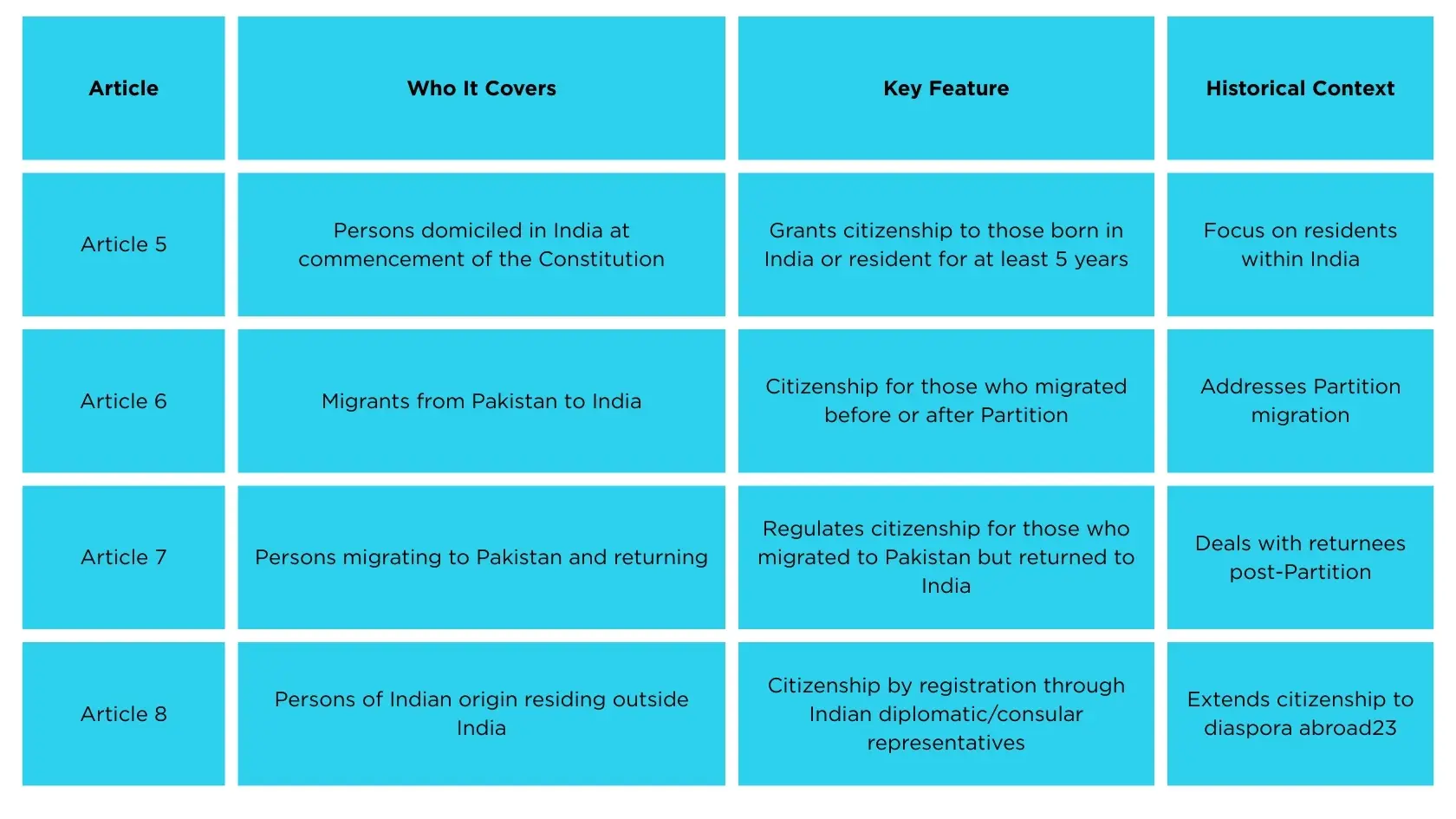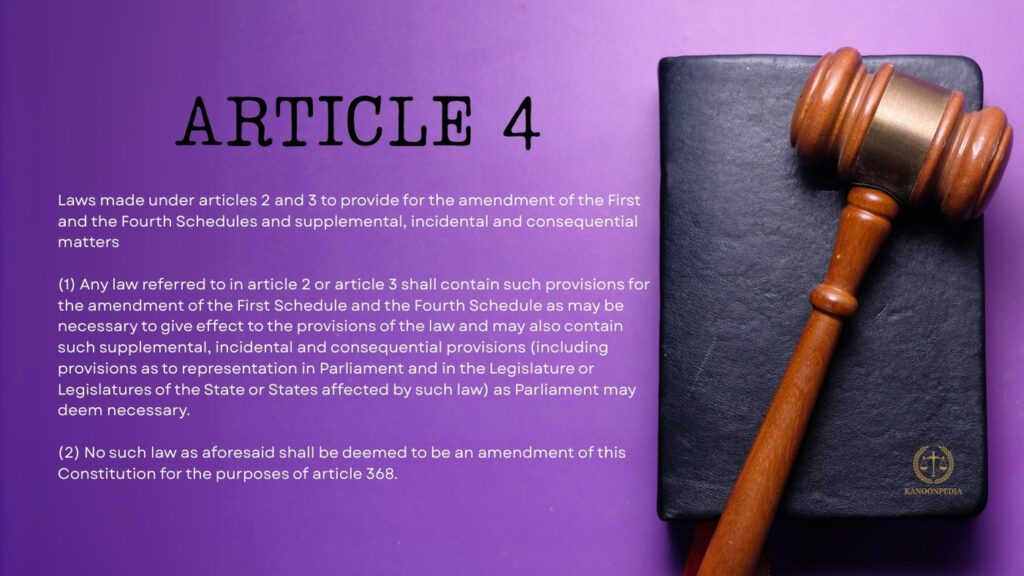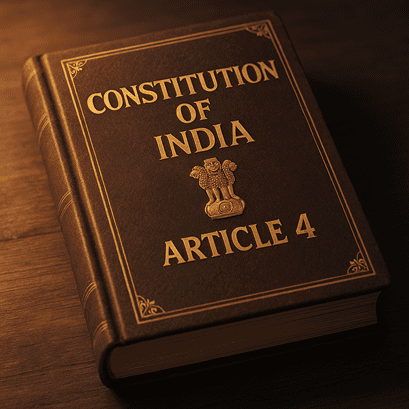Article 4 of the Indian Constitution establishes the procedural framework for implementing changes to India’s territorial organization under Articles 2 and 3. This provision enables Parliament to make necessary amendments to the First and Fourth Schedules and incorporate supplemental provisions when reorganizing states or admitting new territories into the Union.

Table of Contents
Article Bifurcation & Textual Analysis

Article 4 consists of two clauses:
Clause 1:
“Any law referred to in Article 2 or Article 3 shall contain such provisions for the amendment of the First Schedule and the Fourth Schedule as may be necessary to give effect to the provisions of the law and may also contain such supplemental, incidental and consequential provisions (including provisions as to representation in Parliament and the Legislature or Legislatures of the State or States affected by such law) as Parliament may deem necessary.”
Clause 2:
“No such law as aforesaid shall be deemed to be an amendment of this Constitution for the purposes of article 368.”
This provision can be bifurcated into three key components:
- Schedule Amendment Power: Parliament can amend the First Schedule (which lists all states and union territories) and the Fourth Schedule (which allocates seats in the Rajya Sabha) when implementing territorial changes under Articles 2 and 3.
- Supplemental Authority: Parliament can include “supplemental, incidental and consequential provisions” in laws reorganizing states, including provisions for representation in Parliament and state legislatures.
- Simplified Procedure: Laws made under Articles 2 and 3 are not considered constitutional amendments under Article 368, meaning they require only a simple majority rather than the special procedure for constitutional amendments.
The phrase “as Parliament may deem necessary” grants significant discretion to Parliament in determining what supplemental provisions are required when reorganizing states or admitting new territories.
Landmark Judicial Interpretations related to Article 4 of the Indian Constitution
Babulal Parante vs. State of Bombay (1960)
Facts: This case challenged the States Reorganisation Act, 1956, which reorganized states along linguistic lines. The petitioner questioned whether Parliament could make such extensive changes through ordinary legislation.
Legal Questions: Whether laws made under Articles 2 and 3, containing provisions for amending the First and Fourth Schedules, required the special procedure for constitutional amendments.
Court’s Reasoning: The Supreme Court upheld the validity of the States Reorganisation Act, confirming that Article 4 explicitly exempts such laws from the constitutional amendment procedure under Article 368. The Court emphasized that this exemption was deliberately included to provide flexibility in India’s federal structure.
Ratio Decidendi: Laws made under Articles 2 and 3, even when they amend the First and Fourth Schedules, are not constitutional amendments requiring the special procedure under Article 368.
In Re: Article 370 of the Constitution (2023)
Facts: This case examined the reorganization of the state of Jammu and Kashmir into two Union Territories.
Court’s Reasoning: The Supreme Court, while primarily addressing Article 370, also discussed Article 4’s role in facilitating territorial reorganization. The Court noted that Article 4 provides the procedural framework for implementing changes under Article 3, including the power to make necessary amendments to the First and Fourth Schedules.
Key Observation: The Court affirmed Parliament’s authority under Article 4 to include supplemental provisions necessary to give effect to territorial reorganization, including provisions for governance structures in newly formed territories.

Quotable Content for Examinations
From Babulal Parante vs. State of Bombay:
“Article 4 provides a constitutional mechanism for territorial adjustments without requiring the rigorous procedure of constitutional amendments, reflecting the framers’ intent to create a flexible federal structure.”
Constitutional expert H.M. Seervai observed: “Article 4 exemplifies the pragmatic approach of the Indian Constitution, which recognizes that territorial reorganization requires consequential adjustments that should not be burdened by the procedural requirements of constitutional amendments.”
During the Constituent Assembly debates on November 18, 1948, Shibban Lal Saksena expressed concerns about the significant consequences of changing state boundaries through a simple majority, arguing: “State boundaries should be stable and not subject to frequent changes by successive parliamentary majorities.”
Dr. B.R. Ambedkar, defending the provision, emphasized: “The Constitution must provide flexibility for territorial adjustments while maintaining constitutional integrity, which is precisely what Article 4 achieves.”
Historical Context & Evolution
Article 4 was debated in the Constituent Assembly on November 18, 1948. During these discussions, concerns were raised about the significant consequences of changing state boundaries through a simple majority vote. Shibban Lal Saksena (Indian National Congress, United Provinces) argued that state boundaries should remain stable and not be subject to frequent changes by successive parliamentary majorities.
Despite these concerns, no amendments were proposed, and Article 4 was incorporated into the Constitution without modifications. The framers deliberately designed Article 4 to provide flexibility in India’s federal structure, allowing for territorial reorganizations without requiring the more rigorous constitutional amendment process under Article 368.
The historical context of Article 4 is particularly significant given India’s complex territorial evolution post-independence. The provision facilitated numerous state reorganizations, beginning with the linguistic reorganization of states in the 1950s and continuing through the creation of new states in recent decades.
Practical Applications & Contemporary Relevance
Since the Constitution’s commencement, Article 4 has been instrumental in numerous state reorganizations:
- Linguistic Reorganization (1950s): The States Reorganisation Act, 1956, which reorganized states along linguistic lines, was implemented through Article 4’s provisions.
- Creation of New States: Article 4 facilitated the formation of states like:
- Andhra Pradesh (1953)
- Maharashtra and Gujarat (1960)
- Nagaland (1962)
- Punjab and Haryana (1966)
- Chhattisgarh, Uttarakhand, and Jharkhand (2000)
- Telangana (2014)
- Boundary Adjustments: Various acts have altered boundaries between states, such as:
- Bihar and West Bengal (Transfer of Territories) Act, 1956
- Andhra Pradesh and Madras (Alteration of Boundaries) Act, 1959
- Haryana and Uttar Pradesh (Alteration of Boundaries) Act, 1979
- Integration of Territories: Article 4 enabled the integration of territories like Sikkim (1975) and former Portuguese territories (Goa, Daman, and Diu).
Comparative Constitutional Perspective
Article 4 reflects India’s unique approach to federalism:
- Flexibility vs. Rigidity: Unlike many federal constitutions that make territorial reorganization difficult, India’s Constitution provides a streamlined process through Article 4, reflecting a more centralized federal structure.
- Simplified Procedure: While constitutional amendments typically require special majorities, Article 4 explicitly exempts territorial reorganization laws from this requirement, facilitating easier adaptation to changing circumstances.
- Comprehensive Approach: Article 4’s provision for “supplemental, incidental and consequential provisions” allows Parliament to address all aspects of territorial reorganization in a single legislative act, ensuring a comprehensive approach to state formation and boundary changes.
Critical Evaluation

Strengths:
- Provides procedural flexibility for territorial reorganizations
- Enables efficient implementation of changes under Articles 2 and 3
- Balances the need for stability with adaptability to changing circumstances
- Facilitates comprehensive reorganization by allowing for supplemental provisions
Limitations:
- The simplified procedure (simple majority) may not provide adequate safeguards for significant territorial changes
- Potential for political misuse due to the lower procedural threshold
- May contribute to instability in state boundaries if used frequently
- Limited role for affected states in the reorganization process
Constitutional scholar Granville Austin noted: “Article 4 exemplifies the centralized nature of Indian federalism, where the Union government maintains significant control over territorial organization through a simplified legislative process.”
Examination & Advocacy Strategy
For UPSC and Judiciary Examinations:
- Distinguish Between Articles 2, 3, and 4: Clearly articulate that while Articles 2 and 3 grant substantive powers for territorial changes, Article 4 provides the procedural framework for implementing these changes.
- Emphasize the Simplified Procedure: Highlight that Article 4(2) explicitly exempts laws made under Articles 2 and 3 from the constitutional amendment procedure under Article 368.
- Cite Specific Examples: Reference major state reorganizations implemented through Article 4, such as the linguistic reorganization of states in the 1950s and the creation of new states like Telangana.
- Connect with Federalism: Discuss how Article 4 reflects India’s unique “holding together” model of federalism, balancing flexibility with constitutional integrity.
For Legal Advocacy:
- Challenging Reorganization: When representing clients challenging state reorganization, focus on whether the supplemental provisions included in the law are truly “necessary” as required by Article 4.
- Defending Reorganization: When defending reorganization, emphasize Parliament’s broad discretion under Article 4 to determine what supplemental provisions are necessary.
- Procedural Compliance: In cases involving the implementation of territorial changes, ensure that the law properly amends the First and Fourth Schedules as required by Article 4.
Article 4 represents a crucial constitutional mechanism that has enabled India’s federal structure to evolve and adapt over time. By providing a streamlined process for implementing territorial changes, it has facilitated the reorganization of states to better reflect linguistic, cultural, and administrative realities, contributing to India’s unity in diversity.